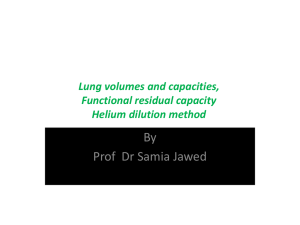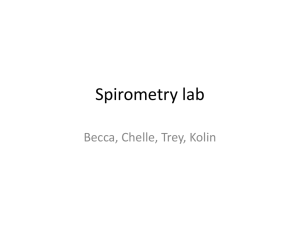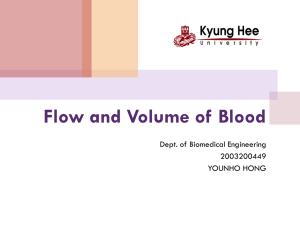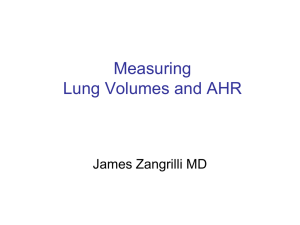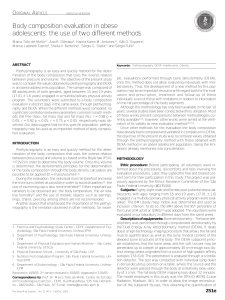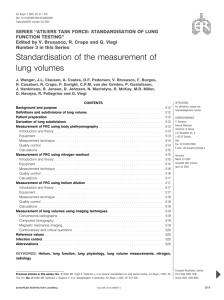Body Plethysmography – Angela Lorenzo MS, RRT, RPFT
advertisement
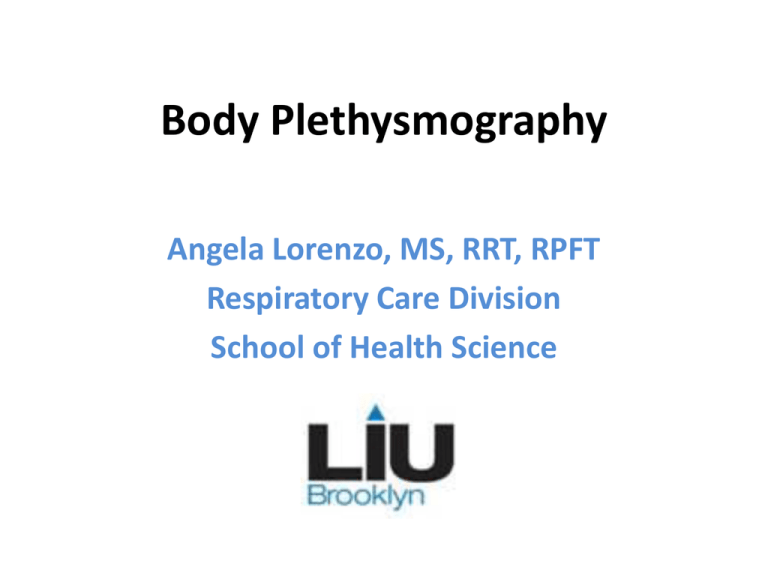
Body Plethysmography Angela Lorenzo, MS, RRT, RPFT Respiratory Care Division School of Health Science We knew this the whole time! • Thank you to those who pioneered our Profession to make it a “Best Job” • Thank you to all in the Profession today who continue to make it a “Best Job” From AARC CPG: Static Lung Volumes Abbreviations Used in this Presentation • • • • • • TV: tidal volume TLC: total lung capacity VC: vital capacity SVC: slow vital capacity FVC: forced vital capacity FRC: functional residual volume • RV: residual volume • ERV: expiratory reserve volume • IRV: inspiratory reserve volume • IC: inspiratory capacity • P: pressure • V: volume • Pleth: plethysmography • FRCpleth: • FRCN2: Measuring Lung Volumes • The VC and all of its components can be directly measured – Tidal volume – Inspiratory reserve volume – Expiratory reserve volume • The RV and all it comprises cannot be directly measured – Functional residual volume – Total lung capacity Tests Measuring RV • • • • • • • Body Plethysmography Nitrogen Washout Inert Gas Testing Chest X-Ray CT Scan MRI All tests have limitations 1799: First Recorded Measure of RV • Sprigg’s article on Sir Humphry Davy: • “describes the measurement of his own lung volumes, including the first recorded measurement of the residual volume. He measured his own rates of oxygen consumption and carbon dioxide production. He is famous for his investigations into nitrous oxide, but he also investigated the effects of breathing nitric oxide and carbon monoxide. He made these observations with a gasometer and analysis of his expired air, and his work anticipates the invention of blood gas analysis.” (from abstract) • Anaesthesia. 2002 Apr;57(4):357-64 Gas Dilution Techniques • Open Circuit: – Nitrogen washout • Closed Circuit: – Inert gas testing • Helium Dilution Nitrogen Washout • • • • A good test Easy to perform, easy to instruct Cost effective in terms of equipment Often time consuming, especially in obstructive patient and patients who arrive with portable oxygen system in use • Difficult to repeat as at least 15 minutes are needed between efforts Calculating FRC and RV Determined by Gas Dilution • • • • • TLC = mean FRC + largest IC, RV = TLC - largest VC Or RV = mean FRC - largest ERV, TLC = RV + largest VC. Helium Dilution Technique • Helium is inert, does not cross the A-C membrane, Images from www.morgansci.com Body Plethysmography • Pre testing patient quotes: – “I’ve got to get IN that box?” – “You’re not going to close that door are you?” • Post testing patient quotes: – “All of a sudden I couldn’t breathe!” – “The air just cut off!” – “You said that would happen but….” Instructing the Patient • Good/effective instructions often take longer than the test • Let the patient know that • Let the patient know it is normal to feel like the air was cut off but that within seconds it will open and be easy to breathe again Technique • Establish a stable resting FRC • At end-exhalation close the shutter valve and have the patient pant gently against the closed airway • Patient must also perform a SVC images from www.morgansci.com Body Plethysmography • Understanding the principle helps get a good test • Boyle’s Law states that P1 x V1 = P2 x V2 at constant temperature • In other words, the product of P and V of a gas is constant when temperature remains constant • P and V vary inversely Body Plethysmography • P1 • V1 • P2 • V2 images from www.morgansci.com Thermal Equilibration is Essential • Can’t short cut this phase of the test or results are inaccurate Graphic Representation Image from ERS: http://dev.ersnet.org/uploads/Document/53/WEB_CHEMI N_2555_1194522257.pdf Image from Medgraphics: Disease Management with Body Plethysmography Poor Timing Closing Shutter Valve Bronchiectasis Sir Humphry Davy • 12/17/1778-5/29/1829 • Penzance, Cornwal, England
